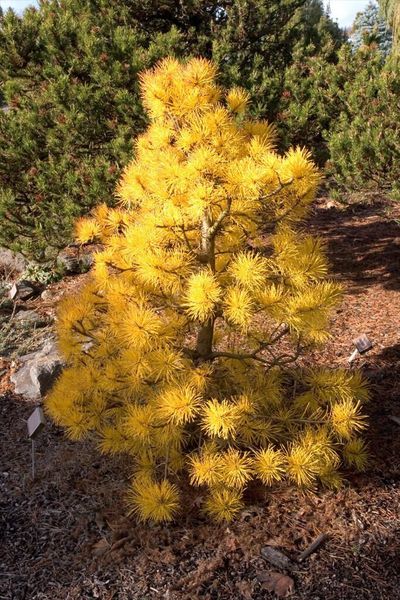Gardening: Chief Joseph pines add pop of color in winter

I admit it, I am an unabashed plantaholic. I’m always looking for that interesting gem I’ve never seen before. Don’t ask me where I’m going to put it, but I’ll find a place somewhere in the garden. Last week while I was at the Northwest Flower and Garden Festival in Seattle, I couldn’t turn down a Chief Joseph lodgepole pine. I’d wanted one for a long time and this one was a good size to haul back across the state, and affordable.
Chief Joseph pine is unusual because its needles turn a brilliant yellow during the winter and a medium green in the summer. Unlike its native cousin the lodgepole pine, it grows only 4 to 8 inches a year, reaching a height of 6 to 7 feet in 10 years. Its branches are often slightly twisted which gives it an interesting structure. It’s size and slow growth makes it perfect for smaller gardens.
The tree was discovered in the late 1970s by Doug Will of Sandy, Oregon, while he was elk hunting in the Wallowa Mountains of northeast Oregon. The unusually colored tree was what botanists call a sport and is a mutation of the ordinary lodgepole pine that is found in the mountains throughout the Inland Northwest. Will took cuttings of the tree and grafted them onto pine rootstock and grew out the first generation of trees. He named it after Chief Joseph, the legendary chief of the Nez Perce, or Nimiipuu, people whose native range includes the Wallowa Mountains. In 1877, Chief Joseph led his people on a 1,400-mile journey through Idaho, Wyoming and Montana chased by the U.S. Army in an attempt to reach sanctuary in Canada.
The tree needs a well-drained soil and once established, is fairly drought tolerant. It needs full sun to reach its brightest winter color. Just a heads up, because its size belies its age, it can be a bit expensive.
While we are on the subject of color, another colorful winter shrub that could share space with the Chief Joseph pine are the red twig dogwoods. The designers of the show gardens used several cultivated varieties of this native plant to brighten the spaces. The cultivated varieties have brightly colored bark that come in shades of red, purple, coral and yellow.
These shrubby dogwoods will grow to 6 or 7 feet and more if they get a lot of water. Because they are a stream bank plant, they will need more water to do well but need only average soil. The first-year stems are the most colorful so to maintain the bright color, several of the older stems need to be removed in the late winter to stimulate new growth. Their leaves turn purple in the fall.
Tip of the week: Some of the stores will soon be getting in their early offerings of bareroot perennials and trees. Pot up your finds and water them well. Set them in your garage until the ground thaws enough to plant them.